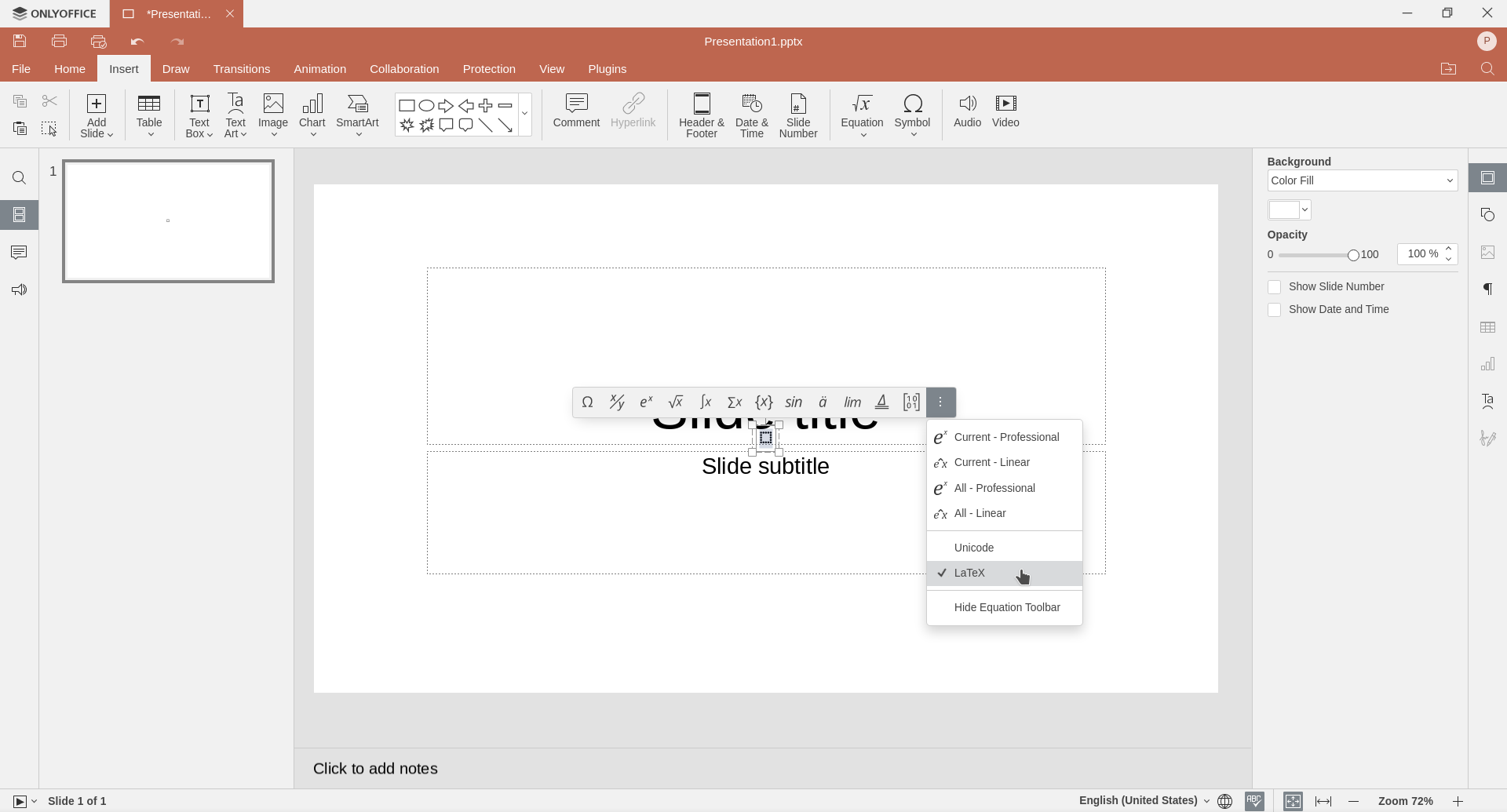In the post-COVID world where so much is done remotely I’m utterly amazed with the absence of a decent app for making slides. I recently went through a long and honestly very disappointing journey for finding the one and only app that fits my needs. And… yeah… there is none. Here are the requirements I have, and I can elaborate more on why exactly I need each of these. So, my perfect presentation making must:
- have interactive UI, where you can drag elements around with your mouse/trackpad;
- support dragging and dropping images AND videos and repositioning them;
- support latex (or at least something similar);
- work on all major OS-s: windows/macos/linux.
That’s it. That’s all I need. Nothing more, nothing less. I’m even willing to pay money to have the app (not as a subscription though)!
I admit that my needs might not be the most common ones, but I also don’t think they’re totally unreasonable.
Here are the apps/frameworks I tried, and where they succeeded and failed (all graded on the scale of 5), starting from the most popular ones.
(a) Microsoft PowerPoint (4.0/5):
+ (4/5) has nice interactive UI and allows for good configurability;
+ (5/5) supports all the major video encodings as well as images and GIFs;
? (4/5) does not support latex, but kinda has its own equation engine which is good-enough;
− (3/5) has no linux counterpart;
− comes bundled with the Office Suite, the majority of apps from which I’ve never used.
(b) Keynote (3.9/5):
+ (4.5/5) has by far the best UI and the collection of tools (perhaps the only thing it lacks is the ability to crop videos);
+ (5/5) same as PowerPoint, supports most of the formats that I typically use;
+ (5/5) has full support for latex equations;
− (1/5) no windows and no linux implementation;
− Mac-only, and the cloud version doesn’t support most of the functionality – so really, fuck you Apple.
(c) Google Slides (2.5/5):
+ (3/5) has a decent UI, but oftentimes feels very clumsy with the overly padded bounding boxes;
? (2/5) supports images and gifs, but fails miserably with videos, which it’s only able to embed over youtube (or google drive);
− (0/5) no latex support, although I’m aware that some paid plugins allow for it;
+ (4/5) it’s web-based, so works essentially on any platform;
− obviously, because it’s web-based, you can’t do anything offline.
(d) LaTeX Beamer (3.3/5):
− (0/5) no UI at all, and getting things line just right is quite a headache;
? (3/5) getting videos is kind of a nightmare really, as it compiles into a pdf, and not all pdf engines support videos;
+ (5/5) no comment;
+ (5/5) no comment, although you have to install an 8 GB-worth latex suite on your system, or do it on a website like overleaf.
(e) LibreOffice Impress (3.3/5):
+ (3/5) the UI is very reminescent of the Google Slides, so is kinda clumsy, although you can get used to it I guess;
+ (4/5) kinda of supports all the major image/video formats, but I’ve had trouble with some of the encodings;
− (1/5) no latex (although third-party plugins can enable it, but they never really worked well for me);
+ (5/5) supported no all major OS-s.
(f) Marp/Slippr/Cafe-Pitch/Reveal.js (3.5/5):
− (0/5) no UI;
+ (5/5) because they all use js-based engine (like electron), you can make any format work with them;
+ (4/5) same here, although some don’t have latex out of the box, it’s relatively straightforward to enable a MathJax or Katex support;
+ (5/5) takes some npm magin, but you can run it on frigging toaster.
(g) Slides.com (3.5/5):
+ (4/5) it basically uses the proprietary version of the reveal.js as a backend, and adds UI (a bit clumsy to my taste, but works ok);
− (2/5) same as above, but adding videos is paywalled;
+ (5/5) there is a full latex support out of the box;
+ (3/5) web-based, but you’ll need an account, and lots of perks are paywalled.
(h) Figma (3.3/5):
+ (5/5) surprisingly good UI (it was made for vector design, so not surprising);
− (2/5) videos paywalled;
+ (3/5) some plugins add latex support, but still quite clumsy;
+ (3/5) has an app and offers a cloud-based web app, but you need to have an account etc.
I also tried other things, like Wolfram Mathematica (yes it can do presentations, although equations look kinda weird), Adobe Illustrator/Inkscape (i mean, why not at this point?), Prezi.com (more fancy, less functional). There are tons of web-based solution (e.g., visme), most of which have a subscription program, which I am not willing to try (I’m ready to pay once, but subscription programs go against my mental stability).
It seems that any solution I try falls short of what I would consider a pretty reasonable list of requirements. At this point I’m mostly using MS PowerPoint, but its lack of linux support really drives me mad. I’m interested to hear your thoughts and your experiences with presentation-making software? What are some of things I should try?
Good read, and I think you might want to look at OnlyOffice. It’s open source and while it is kindof a shameless Microsoft Office clone, it does seem to support LaTeX when adding equations. Not sure how well it works as I don’t use it though. The slides app is pretty decent, the only bone I have to pick with it is that there aren’t many animation types and most of them are very basic. Otherwise, might be what you’re looking for.

Edit: I just tried it and it seems to work pretty well. Select LaTeX, type your equation, then select professional in the dropdown menu and it’ll show the equation.

i tried openoffice, and it’s actually quite decent! the video support is kinda clumsy, because it has no preview at all (the video is basically black unless you make a slideshow, and it also has black boundaries make it square, and you have to manually crop it every time). i also don’t quite like their pushiness about making an account with them and running things on the cloud. but otherwise looks pretty good. i mean the main advantage over powerpoint i guess is the ability to run on linux (and the fact they’re free, which is a huge kudo!)
Not sure if that was a typo but OP mentioned OnlyOffice, not OpenOffice. I don’t think OnlyOffice has ever tried to get me to make an account or do things on the cloud. I keep both Only and Libre installed. I like the UI of Only better, but Libre is more functional, at least as far as spreadsheets go which is my main use.
Sorry yes, i meant onlyoffice. Like i said, it’s indeed quite similar to power point, except for the weirdly looking video embedding. (And of course the fact that it’s free, although i’ve never paid for the powerpoint either :) )
Consider https://remarkjs.com/#2.
Probably doesn’t fit your needs, beacuse there’s no UI.
But there’s no UI, because it’s a file format. For me, that’s a huge plus. I edit it in my favorite text editor. For visual changes, I dip a tiny bit into CSS and HTML.
It’s fast to create, and gives a fantastic cross platform presentation experience.
And it’s trivial to serve the slide decks from a website. And the content is automatically available to search engines.
And…my side decks are immortal. They will outlive the language they were written in. Beacuse under the hood, they’re just Markdown.
Yes, i tried remark. I often use markdown-based solutions when i give a more code-centric presentation. But for other purposes, when I want to make annotations on the slide, put arrows in the right places, combine shapes to make a fast schematic etc, this just doesn’t cut. Sure, technically, it’s possible to do it with mermaid, etc, but it takes exponentially more time.
Yeah. I’ve not been able to accept the tradeoffs of a complex file format and dedicated slide editor. So I use a dedicated image editor when I want to get a bit fancier in my graphics.
That said, I’m also privileged to rarely give a presentation that isn’t code-centric.
Tried Strut ? : https://github.com/MohannadNaj/Strut
Will definitely give it a try, although from the looks of it the project seems abandoned. The last commit was 5 years ago.
Have not looked at it (and Github won’t properly for me right now) but the Github readme had a web link to a newer project of the same author.
yep, but it’s a private repo.
Why does Google Slides only get 4/5 for compatibility?
It literally works on everything. I’m surprised LaTeX scored higher on compatibility, because the install process is heavy (8 GB or more, as you said) and you still have to configure afterwards (e.g. change to XeLaTeX for Unicode support.) IMO, Slides is a 5/5 and LaTeX is a 4/5, for compatibility.
EDIT: Also Google Slides works offline, and you can install it as a PWA by clicking a button in Chrome.
well… it kind of works offline. all the media (at least he videos) are still kept on the cloud. with latex – there are literally free online latex services like overleaf which can also sync with a github for offline use. so i’d say latex, despite its heavy install process, is kinda industry standard at this point. besides, you actually don’t need the whole 8GB of latex to get started on beamer. you can probably get away with as-required installation, which essentially installs only the packages that you explicitly specify in your document. yes, configuring it might indeed be a bit of a headache at first, but with tools like latexmk etc, it’s actually not too bad. and i’d be willing to spend the time to actually tailor the workflow if it had a decent-enough UI and support for videos.
Might be worth looking at Sozi
http://sozi.guide/en/index.html
It saves the presentation as a giant SVG in an HTML file that you can animate. Should be able to convert latex to SVG and add it in. Not sure about video.
Xaringan or typst are great as well
never tried Xaringan, but from the look of it it’s yet another markdown framework. which is splendid, but no UI is a huge dealbreaker for me. otherwise i’m happy to write my own parsing engine or just make presentations in pure html/css/js.
i used typst for papers. their “interpretation” of latex is pretty annoying. they basically tried to reinvent it, and it looks counter intuitive (maybe one could get used to it). otherwise, i don’t see how its different from a regular old beamer with no UI, poor support for videos etc.
Might not have everything, but HedgeDoc (a web-based collaborative markdown editor) has a spreadsheet mode where you can create slideshows / presentations using simple markdown. Its free and self-hostable.
deleted by creator
Agree, but like i said, all the media files are still saved to the cloud and viewed through YouTube.
I am not sure how well they stack up against the competition, as I haven’t really used them, but maybe they can hit the sweet-spot:
KDE has an office suite: Calligra. Windows and macOS support seems to be preliminary, what that means in terms of stability/performance, I don’t know.
As you also mention Figma working decently for you, you could take a look at Penpot.
In regards to your latex situation, maybe klatexformula, could be something for you. It generates images from latex. I’ve been pretty happy with it, in tandem with word processors, before fully jumping to latex. It’s pretty lightweight, their site does mention it needs a minimal version of latex though, which I don’t recall installing when using it, but both texlive, and miktex seem fairly small.
Edit: as others also mention OnlyOffice might also be an option for you.
deleted by creator



